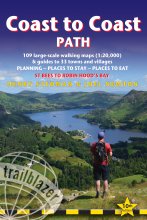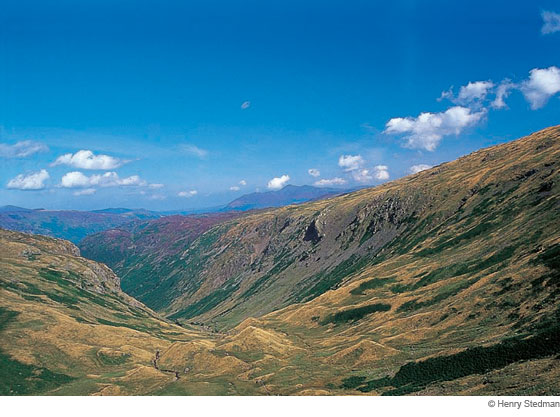'Fantastically detailed and well-presented.'
— Backpack magazine

Coast to Coast Path: St Bees to Robin Hood's Bay
Excerpt:
Using this guide
Contents | Introduction | About the Coast to Coast path | Practical information for the walker | Itineraries | Using this guide | Sample route guide: St Bees to Ennerdale Bridge
Using the guide
The route is described from west to east and divided into 13 stages. Though each of these roughly corresponds to a day’s walk between centres of accommodation, it’s not necessarily the best way to structure your trek. There are enough places to stay – barring a couple of stretches – for you to pretty much divide the walk up however you want. This is even more true if you’re prepared to camp, in which case you can pitch your tent virtually anywhere, as long as you follow the guidelines on p79.
On pp34-5 are tables to help you plan an itinerary. To provide further help, practical information is presented on the trail maps, including waypoints (WPT) and walking times, places to stay, camp and eat, as well as shops from which to buy provisions. Further service details are given in the text under the entry for each settlement.
See box pp91-3 for navigation trouble spots. For map profiles and cumulative distance chart see the colour pages at the end of the book.
TRAIL MAPS
Scale and walking times
The trail maps are to a scale of 1:20,000 (1cm = 200m; 31/8 inches = one mile). Each full size map covers about two miles but that’s a very rough estimate owing to variety of terrain. Walking times are given along the side of each map; the arrow shows the direction to which the time refers. Black triangles indicate the points between which the times have been taken. These times are merely a tool to help you plan and are not there to judge your walking ability. After a couple of days you’ll know how fast you walk compared with the time bars and can plan your days more accurately as a result. See note on walking times in the box on p87.
Up or down?
The trail is shown as a dashed line. An arrow across the trail indicates the slope; two arrows show that it is steep. Note that the arrow points towards the higher part of the trail. If, for example, you are walking from A (at 80m) to B (at 200m) and the trail between the two is short and steep it would be shown thus: A— — — >> — — – B. Reversed arrow heads indicate a downward gradient. Note that the arrow points uphill, the opposite of what OS maps use on steep roads.
Other features
The numbered GPS waypoints refer to the list on pp259-63. Other features are marked on the map when they are pertinent to navigation.

Accommodation
Accommodation marked on the map is either on or within easy reach of the path. Many B&B proprietors based a mile or two off the trail will offer to collect walkers from the nearest point on the trail and take them back next morning. Details of each place are given in the accompanying text. The number of rooms of each type is given at the beginning of each entry, ie: S = Single, T = Twin room, D = Double room, Tr = Triple room and Qd = Quad. Note that many of the triple/quad rooms have a double bed and one/two single beds thus in a group of three or four, two people would have to share the double bed but it also means the room can be used as a double or twin. Your room will either have en suite (bath or shower) facilities, or a private or shared bathroom or shower room just outside the bedroom. Rates quoted for B&B-style accommodation are per person (pp) based on two people sharing a room for a one-night stay; rates are usually discounted for longer stays. Where a single room (sgl) is available the rate for that is quoted if different from the rate per person. The rate for single occupancy (sgl occ) of a double/twin may be higher, and the per person rate for three/four sharing a triple/quad may be lower. At some places the only option is a room rate; this will be the same whether one or two people (or more if permissible) use the room. See p24 for more information on rates.
The text also indicates whether the premises have: wi-fi; if a bath is available either as part of en suite facilities, or in a separate bathroom – for those who prefer a relaxed soak at the end of the day; if a packed lunch can be prepared, subject to prior arrangement; and if dogs (see also p31 and p257) are welcome, again subject to prior arrangement, either in at least one room or at campsites. The policy on charging for dogs varies; some places make an additional charge per day or per stay, while others may require a refundable deposit against any potential damage or mess.
Coast to Coast Path: St Bees to Robin Hood's Bay
Excerpts:
- Contents
- Introduction
- About the Coast to Coast path
- Practical information for the walker
- Itineraries
- Using this guide
- Sample route guide: St Bees to Ennerdale Bridge
Price: £13.99 buy online now…
Latest tweets